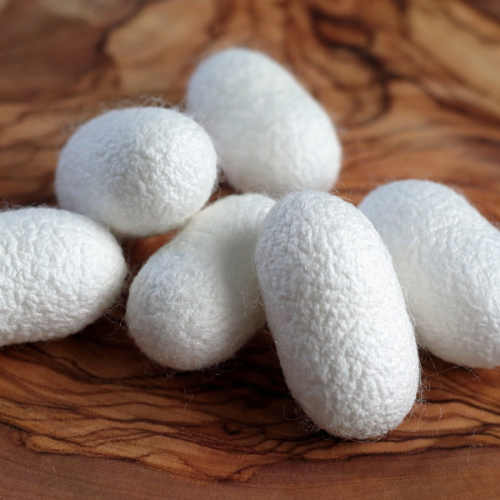Nature never ceases to amaze us with precious gifts, and silk fibroin represents one of its most extraordinary treasures. This structural protein, extracted from silkworm (Bombyx mori) cocoons, is emerging as a key player in regenerative medicine and advanced therapies. While sericin, once considered a simple cocoon "adhesive," has attracted interest for its bioactive properties, it's fibroin – which constitutes 70-75% of silk – that offers revolutionary solutions for tissue regeneration, thanks to its unparalleled mechanical characteristics, biocompatibility, and versatility. The ancient history of silk thus merges with scientific innovation, transforming a textile material into a cutting-edge biomedical platform.
THE STRUCTURAL EXCELLENCE OF FIBROIN
Fibroin has dominated the textile industry for centuries due to its strength (comparable to steel in weight ratio) and flexibility, but it's in biomedicine where it's revealing its full potential. Unlike sericin, which acts mainly as a biochemical modulator, fibroin offers dynamic structural support, essential for guiding the regeneration of complex tissues like bone, cartilage, and skin. Its molecular architecture, organized in β-sheet structures, ensures controlled degradation (up to 12 months) and adaptive mechanical response, mimicking the properties of native tissues.
A 2023 study in Advanced Materials highlights how 3D fibroin scaffolds, with >90% porosity, outperform synthetic materials in bone regeneration, promoting mesenchymal stem cell differentiation into osteoblasts (+85% hydroxyapatite deposition) thanks to the presence of RGD-like sequences, which mediate cell adhesion through integrins. Fibroin acts as an "intelligent" scaffold, releasing mechano-chemical signals that activate signaling pathways like FAK (Focal Adhesion Kinase) and Wnt/β-catenin, crucial for tissue repair.
SUSTAINABILITY AND ADVANCED ENGINEERING
Fibroin extraction embodies the principles of circular economy: the degumming process (sericin removal) uses water and sodium carbonate, with 95% protein recovery and waste reuse for agricultural applications. According to Science Advances (2024), each kg of fibroin produced generates 30% less CO? compared to synthetic polymers like PLA, thanks to the intrinsic energy of raw silk and low processing temperature (60-80°C).
The most innovative applications exploit fibroin's ability to self-assemble into hierarchical structures. Harvard Medical School researchers have developed photo-crosslinked hydrogels that replicate myocardial elasticity (Young's modulus ~10 kPa), enabling cardiac repair post-infarction. Furthermore, functionalization with bioactive peptides (e.g., BMP-2 for bone) allows customization of scaffolds based on clinical needs, paving the way for patient-specific therapies.
MOLECULAR MECHANISMS AND CLINICAL APPLICATIONS
Fibroin's superiority in tissue regeneration lies in its synergy between physical properties and bioactivity. We're talking about mechano-transduction, where forces exerted by the fibrous microstructure activate ion channels (e.g., Piezo1) in cells, triggering the expression of genes like RUNX2 (osteogenesis) and SOX9 (chondrogenesis). In programmed degradation, hydrolysis rate is modulable through cross-linking, synchronizing with neo-tissue formation. In immunomodulation, fibroin reduces TNF-α and IL-6 expression in macrophages, preventing pathological fibrosis and scarring (Biomaterials, 2023). Clinically, fibroin membranes have reduced diabetic ulcer healing time by 50% in a multicenter study (NIH, 2024), while bioengineered tracheal grafts have restored respiratory function in cancer patients.
TOWARDS PERSONALIZED REGENERATIVE MEDICINE
The future lies in the convergence of biofabrication and AI: 3D printers powered by fibroin are creating vascularized tissues with micrometric resolution, while predictive algorithms optimize scaffold design based on patients' genomic data. Fibroin isn't just a material: it's an integrated biological system, capable of dialoguing with the human body to restore, cell by cell, its lost integrity. The revolution has already begun – and weaves its web in the fusion between ancient knowledge and futuristic technology.


